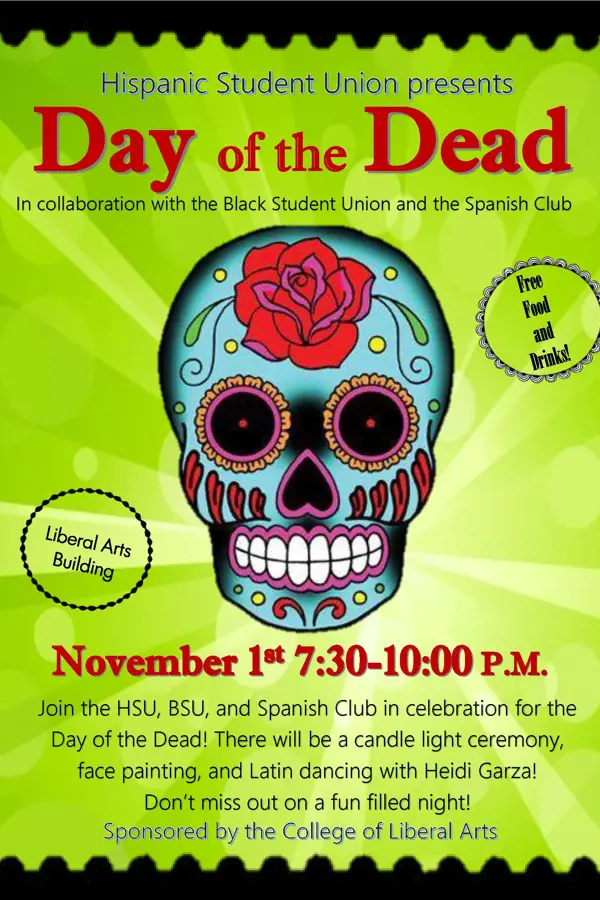
USI to commemorate Day of the Dead with celebration, speech
October 31, 2017
The University of Southern Indiana will commemorate the Day of the Dead at 7:30 p.m. Wednesday, November 1 in the lobby of the Liberal Arts Center. The event is free and open to the public, and light refreshments will be served.
Dr. Manuel Apodaca Valdez, associate professor of Spanish, will present a speech on the history of the Catrina skull, an international symbol of the Day of the Dead celebration.
The commemoration is organized by the Hispanic Student Union Latinos Unidos, Spanish Club and Black Students Union and is sponsored by the College of Liberal Arts. Organizers hope the event will foster awareness about diversity in campus.
For more information about the Day of the Dead, contact Dr. Manuel Apodaca Valdez at mdapodacav@usi.edu or 812-228-5038.
The Catrina Skull
One of the most representative images of the Day of the Dead is the Catrina skull, a popular icon representing an elegant lady with a colorful feathered hat created by Mexican artist José Guadalupe Posada early in the twentieth century.
Posada was born on February 2nd, 1852 in Aguascalietes, Mexico. He spent 12 years in León, a city located in central Mexico, making a career as a printmaker and entrepreneur until 1888 when the city of León was destroyed by a flood that forced Posada and his family to move to Mexico City. Around 1990, he joined the workshop of Antonio Vanegas Arroyo, with whom he would work until his death. With Vanegas Arroyo, Posada produced thousands of illustrations complemented with popular verses for a wide range of publications and newspapers, including El Argo, La Patria, El Ahuizote, and El Hijo del Ahuizote. All of them reflected an open anti-establishment political position. It was during this period that Posada fully developed what was to become popular Mexican graphic art and created the caricatures of his most famous skulls, one of which being the Catrina skull.
For the most part, Posada's illustrations were political satire images. This period of the Mexican history was called the Porfiriato, as the dictator ruling Mexico was President Porfirio Diaz. Focusing on daily life events, Vanegas Arroyo and Posada produced a vast and inexpensive illustrated literature for the lower class. These leaflets and booklets satirized many poignant issues of the day.
Posada's work influenced the Mexican muralism art movement of the post-revolutionary period. Diego Rivera's mural, Dream of Sunday Afternoon in Alameda Park, portrays Posada at the center of the famous fifty-foot fresco sided by an elegant Catrina skeleton. It is likely that Catrina as a symbol of the urban bourgeoisie at the turn of the nineteenth century began with this image of Diego Rivera. Another of the three great Mexican muralists, Jose Clemente Orozco, also paid homage to Posada's work in his memories: "Posada is like the true great artists, an admirable lesson in simplicity, humility, equilibrium, and dignity" (La Jornada Semanal, 3 Feb. 2002). It was only after his death, that Posada's work became recognized on a national and international level. In the 1921, French artist Jean Charlot recognized the importance of Posada's engravings and published some of them in France and Europe. He described Posada as "Printmaker to the Mexican people". (The Public Domain Review).
When did Posada create his renowned Catrina skull?
La Catrina, Posada's most compelling and festive icon, was one of his latest creations and was not published during his lifetime. Posada created the Catrina skull in 1912, but it was not published until ten months after his death on January 20, 1913. There are at least two versions about the significance of the image: one says that she is a caricature of high class women of his time. By portraying a wealthy, fancy French-style woman in her expensive dress, and feathered hat, Posada wanted to fuel opposition to the dictatorial regime. The other version says that La Catrina was originally called the "Calavera Garbancera," which represents indigenous and low-class women who aspire to look like European aristocratic women in the pre-revolution era.
What do "garbancera" and "catrina" mean?
On the one hand, "garbancera" is a derogative popular term to call someone that only eat chickpea, relating in this case to low-class women. On the other hand, "catrina," although less derogative, is a Mexican term referring to someone who dresses fancy or with elegance. Both terms are out of the Mexican jargon nowadays, but "catrína" can be found in literature and film of the first half of the twentieth century. Whatever the skull name was initially, the origin of the Catrina skull is now more a part of the legend than of real history, an icon that has become not only a symbol of the Day of the Dead, but also of Mexican identity in many ways.